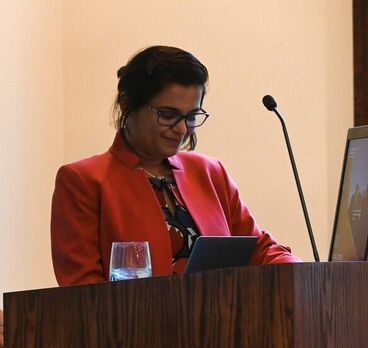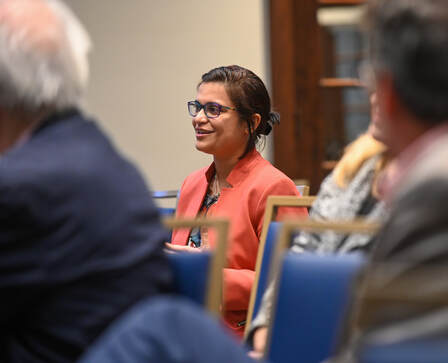on the path of a strong woman
By Sam Marie Engle
What do you do after you complete diagnostic radiology residency? If you are Dr. Ila Sethi, you move to another country, complete fellowship training in one subspecialty, and then start all over again in another.
What do you do after you complete diagnostic radiology residency? If you are Dr. Ila Sethi, you move to another country, complete fellowship training in one subspecialty, and then start all over again in another.
an unusual path

“Looking back, that’s how it was supposed to happen,” she says about her circuitous career path. “In India, you finish high school and then write a countrywide exam to get into medical school. And how well you do on the exam determines whether or not you get in. In med school, I had some classmates who took the exam three or four times; that’s how hard it is.” Dr. Sethi had to wait a year before passing the second time. “It taught me patience.”
She earned her MD and completed diagnostic radiology residency at Jawaharlal Nehru Medical College, AMU in Aligarh. All set to be a radiologist, “life happened.” She moved to Washington, DC, where she not only completed a fellowship in neuroradiology at George Washington University, she also discovered nuclear medicine.” (Nuclear medicine is not part of radiology in India, so she had no prior exposure.)
“Nuclear medicine chose me,” she says simply. She quickly applied for nuclear medicine residency and matched with Emory.
She earned her MD and completed diagnostic radiology residency at Jawaharlal Nehru Medical College, AMU in Aligarh. All set to be a radiologist, “life happened.” She moved to Washington, DC, where she not only completed a fellowship in neuroradiology at George Washington University, she also discovered nuclear medicine.” (Nuclear medicine is not part of radiology in India, so she had no prior exposure.)
“Nuclear medicine chose me,” she says simply. She quickly applied for nuclear medicine residency and matched with Emory.
fulfillment
“Every aspect of what we do is fulfilling,” she says. “In nuclear medicine, the majority of what we read is oncologic imaging. We are trying to define a new standard of care.” Dr. Sethi points to the provision of Lu-177 for prostate cancer patients and Yittrium-90 therapy for patients with primary or secondary liver cancer as just two examples of the way she and her colleagues are advancing treatment options for patients. She also appreciates the palliative aspects of care. “We see terminally ill patients with short time to live, or patients with difficult-to-treat cancers, and I’m able to help them. If I’m coordinating care with their physician or giving symptom relief, I’m still making a real difference. It’s rewarding.”
Dr. Sethi’s proud that Emory has been designated a Comprehensive Radiopharmaceutical Center of Excellence by the Society for Nuclear Medicine and Medical Imaging. That designation recognizes the integration of patient care with training the next generation of nuclear medicine providers and connecting care with research, including clinical trials.
Dr. Sethi enjoys teaching. “There are times when I’m in the reading room or on Zoom and hear from residents “oh, I never thought about that” or “wow, I learned something,” or they think about how they can apply something in the future; that gives me a real sense of achievement.”
Dr. Sethi’s proud that Emory has been designated a Comprehensive Radiopharmaceutical Center of Excellence by the Society for Nuclear Medicine and Medical Imaging. That designation recognizes the integration of patient care with training the next generation of nuclear medicine providers and connecting care with research, including clinical trials.
Dr. Sethi enjoys teaching. “There are times when I’m in the reading room or on Zoom and hear from residents “oh, I never thought about that” or “wow, I learned something,” or they think about how they can apply something in the future; that gives me a real sense of achievement.”
making a difference for women

Another difference she makes is by being a woman in a male-dominated field. According to a 2021 study, about 29% of nuclear medicine faculty members are women[1]. At Emory, Dr. Sethi is one of three women on the 17-member nuclear medicine faculty. The Class of 2022 comprised three men; the first-year class this year comprises two women.
“It’s not easy for women no matter where they are. Women always have to work harder than their male counterparts to prove they are good enough, even if they are better. It happened in India: there would be patients lined up waiting to see the doctor and they kept thinking I was a nurse. Even here at Emory, if I am with a male trainee, I’m seen as the nurse and the trainee is seen as the "real" doctor. It’s so deeply rooted in our societal values. We’ve come a long way, for sure, and I wholeheartedly acknowledge how much we have gained, but we are not there yet.”
She continues. “A few years back I entered a store, browsing. I came across this teen magazine that had a young girl on the cover with a story teaser: “How to look pretty when you get up in the morning.” I was appalled and disgusted by that magazine. What are we teaching our daughters and next generation? That speaks volumes about how society thinks.”
Mentorship matters for career success, especially in medicine, and there’s a huge lack of mentors for women,” Dr. Sethi says. “There are challenges I would have that a male colleague never faces so who do I talk to about them? If I am trying to push the glass ceiling, who is there to lift me? The truth is I had to be my own trailblazer and be my own mentor.”
She is changing that for female residents. “On a day-to-day basis, when I am talking to these residents, I always talk about the challenges. Awareness is the key. I share with them my journey and also my tips and tricks. What works and doesn’t. How to look for allies. See what resources are available to you. I always share my resources and tips with my trainees, including those for personal life balance. They have to be prepared for what they’ll face after residency.”
Dr. Sethi looks for opportunities to teach and help others in everything she does. As the secretary of the southeastern chapter of SNMMI, she pushes residents to get involved and be seen. “You have to create a space for yourself, I tell them.”
For the past three years, Dr. Sethi has been co-directing Emory Radiology’s Grand Rounds and Visiting Professor program. She sees Grand Rounds as an opportunity to help others through professional development. This year she is the sole director but is looking for a co-leader. “It’s an excellent experience – interacting with such accomplished speakers from across the country who are more than happy to share their wisdom with you, not just on their invited topic but on the profession in general. I really value that.”
“It’s not easy for women no matter where they are. Women always have to work harder than their male counterparts to prove they are good enough, even if they are better. It happened in India: there would be patients lined up waiting to see the doctor and they kept thinking I was a nurse. Even here at Emory, if I am with a male trainee, I’m seen as the nurse and the trainee is seen as the "real" doctor. It’s so deeply rooted in our societal values. We’ve come a long way, for sure, and I wholeheartedly acknowledge how much we have gained, but we are not there yet.”
She continues. “A few years back I entered a store, browsing. I came across this teen magazine that had a young girl on the cover with a story teaser: “How to look pretty when you get up in the morning.” I was appalled and disgusted by that magazine. What are we teaching our daughters and next generation? That speaks volumes about how society thinks.”
Mentorship matters for career success, especially in medicine, and there’s a huge lack of mentors for women,” Dr. Sethi says. “There are challenges I would have that a male colleague never faces so who do I talk to about them? If I am trying to push the glass ceiling, who is there to lift me? The truth is I had to be my own trailblazer and be my own mentor.”
She is changing that for female residents. “On a day-to-day basis, when I am talking to these residents, I always talk about the challenges. Awareness is the key. I share with them my journey and also my tips and tricks. What works and doesn’t. How to look for allies. See what resources are available to you. I always share my resources and tips with my trainees, including those for personal life balance. They have to be prepared for what they’ll face after residency.”
Dr. Sethi looks for opportunities to teach and help others in everything she does. As the secretary of the southeastern chapter of SNMMI, she pushes residents to get involved and be seen. “You have to create a space for yourself, I tell them.”
For the past three years, Dr. Sethi has been co-directing Emory Radiology’s Grand Rounds and Visiting Professor program. She sees Grand Rounds as an opportunity to help others through professional development. This year she is the sole director but is looking for a co-leader. “It’s an excellent experience – interacting with such accomplished speakers from across the country who are more than happy to share their wisdom with you, not just on their invited topic but on the profession in general. I really value that.”
from strength to strength
Far from a lone ranger, Dr. Sethi thrives on Emory Radiology’s collaborative culture. She’s the first to help and to engage in group activities. An avid hiker, Dr. Sethi not only enjoys treks with her eight-year-old son, she’s looking for colleagues interested in starting a hiking club. “I love being part of a group and discovering new paths to take.”
If there’s a downside to being so other-minded, it’s that it can be misinterpreted. “Sometimes people misinterpret kindness for weakness. I’m someone who goes out of my way to help but that doesn’t mean I’m not strong.”
Looking at her accomplishments, the many obstacles she’s overcome, her ability to thrive in an emotionally and mentally demanding subspecialty, and the fierce commitment she has to ensuring her residents succeed and her patients receive the highest quality care, we see strength radiating from her.
[1] J Nucl Med 2021; 62:1207–1213, at https://jnm.snmjournals.org/content/jnumed/62/9/1207.full.pdf.
If there’s a downside to being so other-minded, it’s that it can be misinterpreted. “Sometimes people misinterpret kindness for weakness. I’m someone who goes out of my way to help but that doesn’t mean I’m not strong.”
Looking at her accomplishments, the many obstacles she’s overcome, her ability to thrive in an emotionally and mentally demanding subspecialty, and the fierce commitment she has to ensuring her residents succeed and her patients receive the highest quality care, we see strength radiating from her.
[1] J Nucl Med 2021; 62:1207–1213, at https://jnm.snmjournals.org/content/jnumed/62/9/1207.full.pdf.